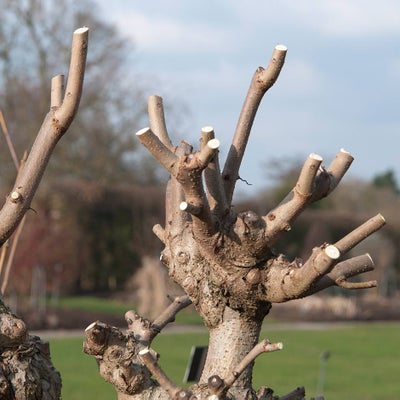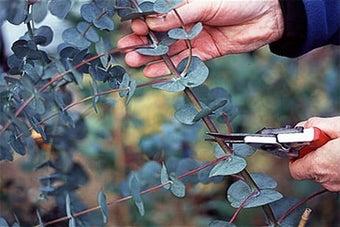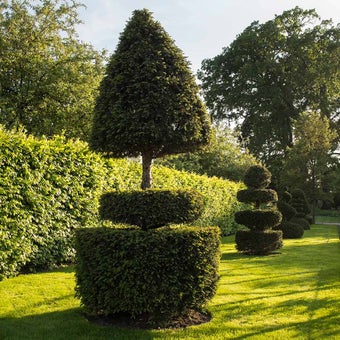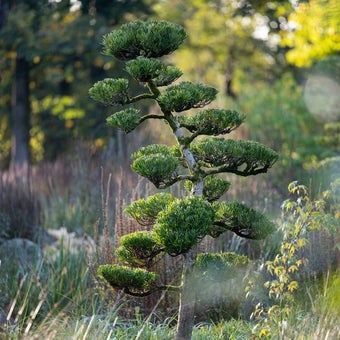
Quick facts
Suitable for - Most on London plane and common lime
Timing - Late winter (except acers)
Difficulty - Moderate (but usually requires a professional because of working at heights and with chainsaws)
Suitable for...
Pollarding is a pruning technique used for many reasons, including:
- Preventing trees and shrubs outgrowing their allotted space
- Pollarding can reduce the shade cast by a tree
- May be necessary on street trees to prevent electric wires and streetlights being obstructed
These are a few of the plants it can be used on:
- Ash (Fraxinus)
- Common lime (Tilia × europaea)
- Elm (Ulmus)
- Elder (Sambucus)
- Gum (Eucalyptus)
- London plane (Platanus × hispanica)
- Mulberry (Morus)
- Oak (Quercus)
- Some species of Acer (A. negundo and its cultivars)
- Tulip tree (Liriodendron)
Pollarding a tree is usually done annually, and would need to be carried out every few years to avoid potential problems. This usually involves hiring an arborist, so can be expensive. Why not consider the following before pollarding:
- Plant a tree small enough to fit its allotted space. This will only need minimal pruning
- Try other pruning options suitable for large trees, such as crown or crown reduction (ask your arborist)
When to pollard
The best time for pollarding many trees and shrubs is in late winter or early spring. However, bear in mind the following:
- Avoid pruning Acer species in spring when they are prone to bleeding sap. Summer can be a suitable time to pollard. However, the new growth may be poor as a result of the scorch, drought or heavy shade cast by neighbouring trees
- The least favourable time for pollarding is the autumn, as decay fungi may enter the pruning cuts
How to pollard
Young trees
Once young trees or shrubs have reached the desired height, you can begin to pollard them. This involves choosing a framework:
- On a shrub, this might be one stem cut to a metre high – a mass of stems will grow from the top
- With a tree, it is more typical to leave a trunk supporting three or five branches – these branches are cut back to a desirable length and the twiggy growth appears at these ends
Initially, the new branches are held weakly in place as they grow rapidly from underneath the , rather than from within the tree. As the wood lays down annual growth rings, the union strengthens, often forming a thickened base where the shoot meets the trunk. Over a number of years, a swollen 'pollard head' forms where new shoots grow each year.
Maintaining a pollard
Once a tree or shrub is pollarded, continue the annual cycle of cutting.
- Branches should be pruned just above the previous pollarding cuts
- In some cases, such as where some leaf cover is required, leave some branches intact or cut back to a side branch
Rejuvenating an overgrown pollarded tree
Seek advice from an arborist before doing any work. Although having a tree pollarded regularly is expensive, an overgrown pollard may require more surgery to remove larger parts of the tree at a greater height.
Try the following to rejuvenate an overgrown pollarded tree or shrub:
- Remove any spindly and weakly-attached branches
- Consider whether the branches can be thinned out, and reduced in length, to create a tree-like framework, effectively restoring the pollard to a tree
- It may be possible to remove all the branches that have grown from the stumps of the old pollards. London plane (Platanus × hispanica) responds to this treatment
- Horse chestnut (Aesculus × hippocastanum) needs to be cut to a higher point in the tree, rather than to the original pollards. This avoids exposing large amounts of old wood, but creates a second set of pollard heads
- In some cases, such as with hornbeam (Carpinusbetulus) and ash (Fraxinusexcelsior), it is beneficial to retain some of the branches. Likewise, some oak trees, such as Quercus robur and Q. petraea, do best when substantial portions of their main branches are retained
After any major work, the tree should be monitored for any further maintenance required.
Problems
Trees with weaker wood prone to producing multiple shoots, such as poplar (Populus) and willow (Salix) can become hazardous. Some of the weakly-attached branches can break off and fall to the ground. Ideally, try to return to a frequent cutting cycle and have an arborist carry out a safety check regularly.
A similar problem can occur with trees such as beech (Fagus sylvatica), oak (Quercus robur) and sweet chestnut (Castanea sativa). The branches become heavy when pollarding lapses for several decades, and these may break away in windy weather. Consult an arborist, if you are in any doubt.










